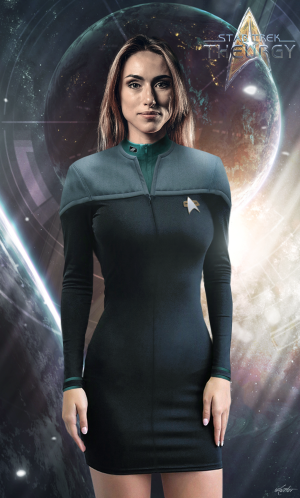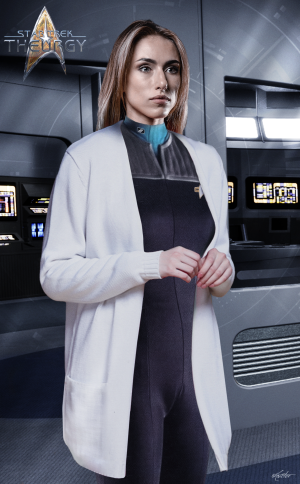Nara Nueva: Difference between revisions
From Star Trek: Theurgy Wiki
| Line 91: | Line 91: | ||
'''APPEARANCES:''' | '''APPEARANCES:''' | ||
Interregnum 01-02: S02 | |||
Considered variables: Wherein Nara gives her thoughts on recent events in [[Qo'noS|Qo'NoS]] and hwo they affect her.[[https://uss-theurgy.com/forum/index.php/topic,3264.0.html]] | Considered variables: Wherein Nara gives her thoughts on recent events in [[Qo'noS|Qo'NoS]] and hwo they affect her.[[https://uss-theurgy.com/forum/index.php/topic,3264.0.html]] | ||
Revision as of 22:35, 2 November 2021
 | |||
| |||
|---|---|---|---|
| Name: | Nara Nueva | ||
| Rank: | Crewman 1st Class | ||
| Position: | Lab Tech, (High Energy Physics) | ||
| Species: | Human | ||
| Age: | 35 | ||
| Gender: | Female | ||
| Orientation: | Pansexual | ||
| Birthplace: | New Rotterdam, Vega Colony | ||
| Height: | 5'11" /182 cm | ||
| Weight: | 140 lbs / 63kg | ||
| Hair: | Auburn | ||
| Eye color: | Brown | ||
| Played by: | Stock Model | ||
| Writer: | Tae | ||
| Interests | |||
| Judo
Running Weightlifting Reading Music Art | |||
| Education | |||
2363-2371: Copernicus University, New Rotterdam, Vega Colony 2371-2374: Starfleet Academy, San Francisco, Earth | |||
| Service Record | |||
| 2371-2374: Cadet, Starfleet Academy
2374-2376: Ensign, Science officer, USS Oberth-A , NCC 602-A 2376-2379: Lieutenant Junior Grade, Researcher, Daystrom Institute 2379-2381: Crewman 1st Class, Administrative Aide, Federation Embassy on Qo'noS 2381-Present: Crewman 1st Class, Lab Tech, USS Theurgy | |||
| Decorations | |||
| 2363: Recipient of Thorne-Hawking Scholarship
2371: Zee-Magnees Prize 2379: Demoted | |||
Nara Nueva served at the Federation Embassy on Qo'nos in relative exile until her defection to the USS Theurgy as a lab technician, where she aided in the opposition of the parasites that compromised Starfleet Command in the end of the 24th Century.
Biography
Nara Nueva was born in New Rotterdam in 2347 to Magnolia Shepherd, who died in childbirth due to unforeseen complications. Since her father was not present or living, she was immediately placed up for adoption and was adopted at the age of 2 weeks by Ivan Skavinksy, a professor of mathematics at Copernicus University, and Abdul Amir, a sculptor who specialized in abstract art. Her fathers gave Nara a good life and fostered an early education with a focus on the arts and sciences. This early focus on academics and art leads to developing a keen mind capable of adapting and looking at new situations from the strictly logical and the abstract, a trait she'd find helpful beyond measure in her career and education.
Once Nara formally began her schooling, it became clear from the earliest classes that she had a great aptitude in the sciences. This love of the sciences and the intensity with which she pursued those studies was matched only by a love of athletics first found by running against her classmates in free periods. Nara quickly developed a competitive streak amongst her classmates regarding physical challenges. Sports were an area where other students could beat her, and she wasn't always a match for or against her peers. Athletically Nara did her best to challenge herself there. With the lower grade levels, it was made clear quite swiftly just how much the early education imparted by her fathers aided her in her early development and with continued tutoring when not attending classes.
At the age of 16, due to her consistent academic performance in the sciences Nara was awarded the Thorne-Hawking Scholarship to study at Copernicus University. The scholarship was granted in part due to a project in the final year of her schooling that dealt with interactions between solar radiation and planetary magnetic fields and how the installation of large-scale orbital structures perturbs them. The study primarily focused on how magneto-sensitive species are affected by slight changes in the shape of planetary magnetic fields. While there were no conclusive findings made, Nara was recognized for her efforts with the scholarship.
At Copernicus University, Nara quickly found her course of study and focus in high energy particle physics. This particular course of study was inspired heavily by the namesake of her research, Dr. Stephen Hawking. Finding his theories about Hawking radiation quite fascinating, Nara poured herself into those studies with as near a competitive spirit as she had on the track or in the ring when practicing Judo. However, her competitive drive was centered on herself in this regard, wanting to learn more about the genesis of a theory spawned in the 1970's that proved to be quite close to accurate once the first in-person studies of black holes was able to be performed.
The research into black holes and Hawking radiation fostered a drive to delve into theoretical high energy particle physics research. The academic road she chose was a long one filled with countless hours of study, observations, and research. The only that that kept her human at times were the meals with her fathers, where they'd discuss the days events not pertaining to their jobs or research. The familial connection was a grounding force in Nara's life, and something she came to treasure looking back. During one of these dinners, Abdul was speaking about a piece he'd been commissioned to do, an abstraction of a solar flare for a local planetarium, that Nara's doctoral thesis came to her.
Beginning on her thesis early, Nara hypothesized that magnetism and fusion were not the only instigating factors in stellar behaviors such as sunspots and solar flares. The crux of this was the theory that interactions between exotic particles and radiation types could penetrate and perturb the magnetic fields of 'normal' stars and cause stellar phenomena formerly thought to be wholly internal in nature. Over the following four years, Nara slowly put her research together scheduling what time she could with the Univerity's observatory and probes of the local stars and others in the stellar neighborhood. While stable G and M-type stars were part of the focus of her research, the main focus was centered on the rare Wolf-Rayet type stars. The reason for the observation of these particular stars was due to the highly energetic nature and wildly variable properties of stars with this classification.
The theories of her work were proven to be accurate in the case of Wolf-Rayet stars. It was found that nearby sources of exotic particles, usually from neutron stars, or other highly energetic phenomena in the relative area, could indeed influence the behavior of stars. In-depth analysis of materials sampling from Wolf-rayet stars showed a higher than the margin of error presence of tetryon and Metreon particles in most cases and more exotic particles in a few others. Compared to more stable G and M type stars distance from exotic particle sources, it was reasonably concluded that the presence of these particles did indeed have an effect on stellar behavior.
Her findings and summary thesis on "Exotic particle effects on the behavior of stellar behavior' saw Nara graduating with her Doctorate in Particle physics from Copernicus University along with the Zee-Magnees prize being awarded for discoveries in Astrophysics and Particle physics. This was quite easily the crowning moment of the 23-year-old woman's life. Walking across the stage to receive her award from her Father Ivan was the proudest moment in their lives. The receipt of the Zee-Magneees prize earned Nara her acceptance into Starfleet Academy. Nara's desire to enter the academy was the result of a drive to go and do some of the field work herself. While primarily a lab and theory person, Nara did have an itch to explore. And with access to a posting in a Starship or Research Institute she could better make initial observations and determine if observations matched with theory.
Nara's time at the Academy was focused almost wholly on becoming a proper Science Officer. While Nara became more of a generalist, her primary focus remained particle physics. The Academy was easy for Nara, and the physical training was a breeze for the physically inclined woman, and she participated on the Academy Track team, specializing in the 400 and 800 meter distances. One of her personal activities was in reaching out to her peers. This was a task that was necessary to the young woman since she'd been so focused on her academics previously that she'd generally neglected to cultivate much of a social circle. This being the case, Nara developed a friendship with a Cadet Cross, a Vulcan-Bajoran hybrid with a troubled past and having his own issues fitting in with group dynamics. In a study group for general courses she befriended Elro Kobol, making his acquaintance. While she never pried into his past, she was there as a friend to the man, helping him get through his time at the Academy and providing a gym partner, science tutor, and simple friend where applicable.
Following graduation, Nara found her first posting on the USS Oberth-A NCC-602-A, a newly commissioned Intrepid-class ship. This was one of the few ships during the Dominion war tasked with actual scientific research. As it happened, the Oberth was tasked with studying energetic particles and their interaction with local space and sub-space. The goal of this research was part of an objective to better track fleet movements by detecting the unique particle signatures from the phased polaron beam weapons equipped on Dominion ships. It was hoped that by tracking local fluctuations in Polaron signatures that Dominion ships could be detected even if actively dampening their emissions. The research managed to bear fruit only in specific situations, however. The science department's work determined that the phased polarons emitted by the dominion weapons gave off a particular resonance when interacting with metaphasic particles usually found in stellar nurseries. While the line of research wound up not being particularly useful, the method of detection developed during the one-year project earmarked Nara as a rising star in the field of particle physics within Starfleet, showing that she hadn't peaked at 24.
The following year and after an exemplary personnel report from her commanding Officer Nara was promoted to Lieutenant Junior Grade and a prestigious transfer to the Daystrom Institute, where she was placed on a team examining the effects of energetic particles and radiation. Over the next two years, Nara's team began to perform studies on Tetryon, Polaron, and Thalaron energies and radiations. The work was determined to be theoretical in nature and would be confined strictly to theoretical research. The interest specifically in Thalaron radiation and Starfleet's apathetic nature towards studying it was intriguing to the young Lieutenant. Feeling that no knowledge should be banned under any circumstances she began to grow unsettled with meeting road block after roadblock when pursuing inquiries into the topic. These orders rankled the adept scientist and so Nara began performing modeling experiments in her own time, working out the properties of Thalaron radiation in particular. From her theoretical work on Thalaron particles Nara observed that theoretically, the radiation would dissolve the atomic bonds between carbon and water thereby having a biogenic effect that effectively carbonized organic matter. Her models and mathematical proofs seemed to show that organic matter would be effectively rendered to ash through a "boiling off' effect of the carbon bonds essential for Carbon-based life. Nara kept her research to herself and confined strictly to a private partition for herself on the Institute's computer network until early 2379 when Nara began performing modeling experiments that showed exactly what her math had suggested.
Being horrified and a little emboldened by her early modeling experiments, Nara began to experiment with what would be necessary to defend against Thalaron radiation. Since the radiation appeared to lean inorganic structures alone, and left behind only minimal traces of contamination, she believed that Thalaron radiation simply passed through the atomic bonds of most substances, creating a literal boil-off effect of water molecules. This was a hypothesis that needed to be tested, if Thalaron radiation could permeate otherwise impermeable substances, or if sufficiently thick solid materials stopped it.
During one such modeling experiment that showed yet another failure, she was walked in on by Lieutenant Commander V'Trell, her Commanding officer. Without saying a word, commander V'Trell left the lab and immediately placed an alert to Starfleet security filing the paperwork for conducting illegal research that night. The consequences were swift and deadly for Nara's career. The rising star had instead turned into a meteor. The shining cometary tail extinguished as her career plunged headfirst into the sun it orbited. The following Captin's Mast she suffered was swift and decisive. The research that she'd been engaged in had not been approved of in advance by her CO, and no exemption had been granted. The experiments were quite closely related to a potential weapons test. In the particular experiment that had been interrupted, Nara had been modeling the penetration of Thalaron radiation against meter thick duranium alloy composites, similar in composition to Starfleet hulls. The only thing that saved Nara from a full court-martial was her willingness to accept the judgment, openness, and her notes and private research display. It was determined that while her research did have merit, it was proscribed research. The one and only saving grace was that during the procedure of the mast information came to light gathered by the USS Enterprise-E and Starfleet Intelligence that the use of weaponized Thalaron radiation closely matched Lieutenant Nueva's research.
The result of her mast were the immediate revocation of her commission and demotion to Crewman 1st class. This was followed shortly by reassignment to the Embassy on Qo'nos and her posting as an administrative aide with strictly limited access to computer resources to not engage in her own research. Being vindicated by the observed data closely matching her predictive models did not ameliorate her grievances against her commanding officers for being shortsighted to kick her to the curb. These ill feelings towards her superiors and her exile as a glorified secretary brought Nara a sense of discomfort and ill-ease. Following the events of the USS Theurgy´s arrival on Qo'nos she sought a way out and onto a ship where she could potentially prove her worth once again.
Personality Profile
Originally a polite, cheerful and driven scientist, Nara had become bitter and dissatisfied with her position over the last few years. She sought every chance possible to prove that she should be allowed back into the sciences, even if only as a Lab-tech. Nara had an almost unparalleled rigor to her work that allowed her to approach work from every possible angle and engage with research in a way few others can manage. Off duty, she did her best to be friendly but is constantly on edge about being judged poorly for her demotion and current status. As a result, she can usually be found in a gym or a secluded area such as an arboretum. She needed to begin trusting in herself so that others could trust her.
Physical Profile
Nara was a human woman with a lean muscular build. Her interest in athletics from her academic career onwards led to building a lean physique on a solidly built frame. She was not the sort of person to keep any spare weight on her body. While her focus is on academics, she never neglected her physical training after her schooling, and her competitive career in collegiate track and field ended. She had a piercing gaze and an intense countenance. After her demotion, the standoffish nature became part of how she carried herself, keeping a 'closed off' stance at most times, done with a certain squaring of muscular shoulders and straightening of her proud back. When she was seen smiling, Nara had a brilliant smile that would warm rooms and hearts. When not in a lab setting Nara usually wore her auburn hair long and loose just past her shoulders.
Special Notes
In the Academy Nara was friends with Commander Cross, and Elro Kobol as Cadets at Starfleet Academy.
At the age of 18, Nara chose her own last name, Nueva, using the Spanish word for 'new' to indicate her own path in life.
APPEARANCES:
Interregnum 01-02: S02
Considered variables: Wherein Nara gives her thoughts on recent events in Qo'NoS and hwo they affect her.[[1]]


